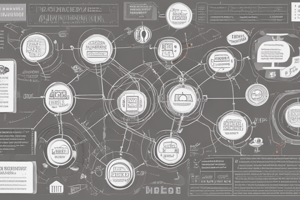Podcast
Questions and Answers
Which type of validity refers to the extent to which a measure accurately reflects the underlying theoretical construct it aims to assess?
Which type of validity refers to the extent to which a measure accurately reflects the underlying theoretical construct it aims to assess?
- External validity
- Face validity
- Construct validity (correct)
- Criterion validity
Which type of case study aims to provide insights into a broader issue or phenomenon beyond the specific case itself?
Which type of case study aims to provide insights into a broader issue or phenomenon beyond the specific case itself?
- Exploratory case study
- Instrumental case study (correct)
- Descriptive case study
- Explanatory case study
In thematic analysis, what is the main goal of generating initial codes?
In thematic analysis, what is the main goal of generating initial codes?
- Reviewing existing themes
- Developing a theory grounded in the data
- Defining and naming themes
- Identifying patterns and ideas within the data (correct)
Which of the following is NOT a type of thematic analysis?
Which of the following is NOT a type of thematic analysis?
What is the primary aim of ethnography?
What is the primary aim of ethnography?
What type of data is collected at specific time intervals?
What type of data is collected at specific time intervals?
Which measure of central tendency is most sensitive to outliers?
Which measure of central tendency is most sensitive to outliers?
A researcher wants to compare the average height of two groups of students. What type of graph would be most appropriate to visualize the data?
A researcher wants to compare the average height of two groups of students. What type of graph would be most appropriate to visualize the data?
What is the purpose of Cohen's Kappa?
What is the purpose of Cohen's Kappa?
Which of these is NOT an assumption of the chi-squared test?
Which of these is NOT an assumption of the chi-squared test?
What type of error occurs when we reject the null hypothesis when it is actually true?
What type of error occurs when we reject the null hypothesis when it is actually true?
What is the difference between a one-tailed and a two-tailed hypothesis?
What is the difference between a one-tailed and a two-tailed hypothesis?
Which of these is a measure of dispersion?
Which of these is a measure of dispersion?
Which of the following assumptions is NOT required for the chi squared test?
Which of the following assumptions is NOT required for the chi squared test?
What does a larger chi squared value indicate?
What does a larger chi squared value indicate?
What is the main characteristic of Spearman’s rho compared to Pearson’s r?
What is the main characteristic of Spearman’s rho compared to Pearson’s r?
Which of the following steps comes first when performing a chi squared goodness of fit test in JASP?
Which of the following steps comes first when performing a chi squared goodness of fit test in JASP?
When calculating Pearson’s r, what must be checked first to confirm the data's suitability?
When calculating Pearson’s r, what must be checked first to confirm the data's suitability?
In an experimental design, what is the primary purpose of controlling extraneous variables?
In an experimental design, what is the primary purpose of controlling extraneous variables?
A researcher finds a chi-squared value of 15.2 with a p-value of 0.03. With $\alpha = .05$, what is the correct interpretation?
A researcher finds a chi-squared value of 15.2 with a p-value of 0.03. With $\alpha = .05$, what is the correct interpretation?
Which of the following indicates the strongest correlation?
Which of the following indicates the strongest correlation?
In the context of hypothesis testing, what is the purpose of setting the power of a study to 0.80 (80%)?
In the context of hypothesis testing, what is the purpose of setting the power of a study to 0.80 (80%)?
When is Spearman's rho a more appropriate measure of correlation than Pearson's r?
When is Spearman's rho a more appropriate measure of correlation than Pearson's r?
What is a key assumption that must be met before conducting a Pearson's r correlation?
What is a key assumption that must be met before conducting a Pearson's r correlation?
A researcher wants to determine if there's a significant association between gender (male/female) and preferred learning style (visual/auditory/kinesthetic). What statistical test is most appropriate?
A researcher wants to determine if there's a significant association between gender (male/female) and preferred learning style (visual/auditory/kinesthetic). What statistical test is most appropriate?
What is a critical assumption that must be checked when conducting a one-sample t-test?
What is a critical assumption that must be checked when conducting a one-sample t-test?
If the Shapiro-Wilk test yields a p-value of 0.02, what does this indicate about the distribution of the data?
If the Shapiro-Wilk test yields a p-value of 0.02, what does this indicate about the distribution of the data?
In JASP, after running a t-test, what output provides a measure of the effect size?
In JASP, after running a t-test, what output provides a measure of the effect size?
What is the primary advantage of using a paired samples t-test compared to an independent samples t-test?
What is the primary advantage of using a paired samples t-test compared to an independent samples t-test?
A researcher is comparing the mean test scores of students before and after an intervention program. What type of t-test is most appropriate?
A researcher is comparing the mean test scores of students before and after an intervention program. What type of t-test is most appropriate?
When conducting a Chi-squared test for goodness of fit, what does the null hypothesis typically state?
When conducting a Chi-squared test for goodness of fit, what does the null hypothesis typically state?
Which type of data are suitable for the Chi-squared test?
Which type of data are suitable for the Chi-squared test?
When running a one sample t-test in JASP, which input is required to specify the value against which the sample mean will be tested?
When running a one sample t-test in JASP, which input is required to specify the value against which the sample mean will be tested?
In the process of statistical analysis, after collecting data but before selecting a specific t-test, what crucial step must be undertaken?
In the process of statistical analysis, after collecting data but before selecting a specific t-test, what crucial step must be undertaken?
When preparing to report descriptive statistics for a study, what is the primary factor that determines whether to report the mean or the median?
When preparing to report descriptive statistics for a study, what is the primary factor that determines whether to report the mean or the median?
In an APA-style write-up of statistical results, what essential elements should be included to provide a comprehensive overview of the analysis?
In an APA-style write-up of statistical results, what essential elements should be included to provide a comprehensive overview of the analysis?
When reporting the Independent Variable (IV) in a research report, what key information should be included to ensure clarity and replicability?
When reporting the Independent Variable (IV) in a research report, what key information should be included to ensure clarity and replicability?
What key piece of information should be included when describing the Dependent Variable (DV) in a research report?
What key piece of information should be included when describing the Dependent Variable (DV) in a research report?
Which of the following is the most appropriate way to examine the normality of data when intending to conduct a paired samples t-test?
Which of the following is the most appropriate way to examine the normality of data when intending to conduct a paired samples t-test?
What does a statistically significant Cohen’s d value indicate?
What does a statistically significant Cohen’s d value indicate?
In an independent samples t-test, what is assessed by Levene's test?
In an independent samples t-test, what is assessed by Levene's test?
In the context of a paired samples t-test, why is homogeneity of variance not directly tested?
In the context of a paired samples t-test, why is homogeneity of variance not directly tested?
Which non-parametric test is the most appropriate alternative to the independent samples t-test when the assumption of normality is violated?
Which non-parametric test is the most appropriate alternative to the independent samples t-test when the assumption of normality is violated?
When conducting a paired samples t-test, what is the purpose of creating a 'Difference' column?
When conducting a paired samples t-test, what is the purpose of creating a 'Difference' column?
What information is gained from examining descriptive statistics, such as the median, when performing a Mann-Whitney U test?
What information is gained from examining descriptive statistics, such as the median, when performing a Mann-Whitney U test?
Why is it important to define the IV and DV early in the research design process?
Why is it important to define the IV and DV early in the research design process?
Flashcards
Face validity
Face validity
It appears to measure what it’s meant to measure.
Criterion validity
Criterion validity
How well one measure predicts an outcome based on another measure.
Exploratory case study
Exploratory case study
Designed to explore a new area of research or generate hypotheses.
Thematic analysis
Thematic analysis
Signup and view all the flashcards
Interpretative Phenomenological Analysis (IPA)
Interpretative Phenomenological Analysis (IPA)
Signup and view all the flashcards
Cohen's kappa
Cohen's kappa
Signup and view all the flashcards
True zero
True zero
Signup and view all the flashcards
Variance
Variance
Signup and view all the flashcards
Standard deviation
Standard deviation
Signup and view all the flashcards
Descriptive statistics
Descriptive statistics
Signup and view all the flashcards
Null hypothesis
Null hypothesis
Signup and view all the flashcards
P value
P value
Signup and view all the flashcards
Type 1 error
Type 1 error
Signup and view all the flashcards
Chi squared test assumptions
Chi squared test assumptions
Signup and view all the flashcards
Goodness of fit test
Goodness of fit test
Signup and view all the flashcards
Chi squared association test
Chi squared association test
Signup and view all the flashcards
Pearson’s r
Pearson’s r
Signup and view all the flashcards
Spearman’s rho
Spearman’s rho
Signup and view all the flashcards
Benefits of correlation design
Benefits of correlation design
Signup and view all the flashcards
Chi-squared test variables
Chi-squared test variables
Signup and view all the flashcards
Correlation test variables
Correlation test variables
Signup and view all the flashcards
T-test variables
T-test variables
Signup and view all the flashcards
Benefits of experimental design
Benefits of experimental design
Signup and view all the flashcards
Assumptions for Chi-squared
Assumptions for Chi-squared
Signup and view all the flashcards
Chi-squared value
Chi-squared value
Signup and view all the flashcards
Power (statistical)
Power (statistical)
Signup and view all the flashcards
P-value significance level
P-value significance level
Signup and view all the flashcards
Parametric test
Parametric test
Signup and view all the flashcards
Non-parametric test
Non-parametric test
Signup and view all the flashcards
One-Sample t-test
One-Sample t-test
Signup and view all the flashcards
Independent Samples t-test
Independent Samples t-test
Signup and view all the flashcards
Paired Samples t-test
Paired Samples t-test
Signup and view all the flashcards
Cohen's d
Cohen's d
Signup and view all the flashcards
Parametric assumptions
Parametric assumptions
Signup and view all the flashcards
Key variables
Key variables
Signup and view all the flashcards
Assumption checks
Assumption checks
Signup and view all the flashcards
Interpreting results
Interpreting results
Signup and view all the flashcards
T-statistic value
T-statistic value
Signup and view all the flashcards
Effect Size (Cohen’s d)
Effect Size (Cohen’s d)
Signup and view all the flashcards
Shapiro-Wilk test
Shapiro-Wilk test
Signup and view all the flashcards
Levene’s test
Levene’s test
Signup and view all the flashcards
Mann-Whitney test
Mann-Whitney test
Signup and view all the flashcards
Study Notes
- True zero represents the complete absence of a measure
- Standard deviation is not a measure of central tendency
Types of Validity
- Face validity assesses if a measure appears to measure what it intends to.
- Construct validity assesses if a measure appears to measure the theoretical construct it's meant to.
- Criterion validity measures how well a measure predicts outcomes against another measure.
- External validity refers to whether the findings can be generalized to other contexts.
Types of Case Studies
- Exploratory case studies explore new research areas or generate hypotheses.
- Descriptive case studies provide detailed accounts of specific cases.
- Explanatory case studies explain the reasons behind particular phenomena.
- Intrinsic case studies focus on specific cases, emphasizing their uniqueness or significance.
- Instrumental case studies provide insight into broader issues.
- Collective case studies involve multiple cases.
- Ethnography includes studies of people in their natural environments.
Types of Thematic Analysis
- Thematic analysis identifies patterns or ideas across multiple data sets.
- Content analysis involves analyzing various sources of data.
- Narrative analysis examines stories from individuals.
- Grounded analysis develops a theory grounded in data collection.
- Discourse analysis is used to study language and communication.
- Interpretative Phenomenological Analysis (IPA) studies lived experiences of individuals.
Process of Conducting a Thematic Analysis
- Familiarize yourself with data.
- Generate initial codes.
- Search for themes.
- Review themes.
- Define and name themes.
- Produce a report.
- Content analysis includes deductive (predefined) or inductive (emerging) categories
Statistical Tests
- Cohen's kappa is a test statistic that considers chance agreement.
- Variance compares participants' original scores to the mean, indicating the overall spread of data points.
- Find the mean of the data set.
- For each data point, subtract the mean and square it to obtain squared deviations.
- Sum the squared deviations and divide by N (for population variance) or N-1 (for sample variance).
- Standard deviation is the square root of the variance, it represents average spread of data points.
Data Types
- Time series is when data are collected at specific time intervals.
- Hierarchical data is organized in a multi-level structure.
- Cross-sectional data is collected at a single point in time.
Graphs
- Histograms are used to visualize distribution and frequency of data.
- Box plots summarize, compare distributions, and identify outliers.
- Violin plots show distribution and variability in more detail.
- Bar charts are used to compare values or densities across categories.
- Bimodal distributions indicate a divide in the data set.
Descriptive Statistics
- Measures of central tendency include mode, median, and mean.
- Measures of dispersion include range, IQR, variance, and standard deviation.
Skewness and Kurtosis
- Kurtosis describes the shape of the distribution and measures the tailedness (peak).
- Positive skew longer tail on right Mean > Median
- Negative Skew longer tail on left Mean Median.
Types of Hypotheses
- Null hypothesis: states there will be no effect or relationship.
- Alternative hypothesis: states there will be an effect or relationship.
- Alternative hypothesis can be either one-tailed (direction specific) or two-tailed (direction not specified).
- P value: the probability of obtaining the observed data.
- Z score: measures how far a single data point is from the mean, used to compare different data points.
Errors in Hypothesis Testing
- Type 1 error (false positive): rejecting the null hypothesis when it's true.
- Type 2 error (false negative): failing to reject the null hypothesis when it's false.
- Alpha threshold of 0.05 determines the threshold for rejecting the null hypothesis.
Chi-Squared Test
- Assumptions for a Chi-Squared Test (all tests are two-tailed, direction not specified):
- Nominal or ordinal data.
- Mutual exclusivity: categories/variables are mutually exclusive and independent.
- Expected frequency should be more than 5 for each cell to ensure validity.
- Independence of observations: every observation in the dataset is independent.
- Random sampling: data comes from a random sample to ensure representativeness and avoid bias.
Goodness of fit test (one variable)
- It includes frequency tables.
- A larger chi-squared value indicates a greater difference between observed and expected frequencies whereas as a smaller chi-squared value indicates a smaller difference between observed and expected frequencies.
- Degrees of freedom (df) define the room of variation allowed.
- Test of association (two variables):
- Calculate the expected frequencies for each cell.
- Alpha threshold- .05 determines the threshold for rejecting the null hypothesis.
- Power 80 translates to a 20% chance of making a type 2 error.
Studying That Suits You
Use AI to generate personalized quizzes and flashcards to suit your learning preferences.




